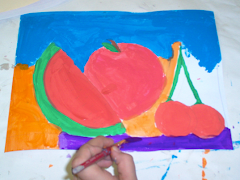Fifth grade visual arts students will be able to identify and use visual arts vocabulary and concepts, and apply basic skills and techniques.
How you can help your child with Visual Arts:
Display artwork around the home and workplace.
Keep a variety of art materials available.
Encourage safe use of material and clean-up practices.
Do art projects with your child.
Talk about the art objects in your home.
Sign, date and save some artwork in a folder.
Visit online galleries, museums and cultural events.
Your child needs to understand and apply Visual Arts concepts, vocabulary and skills in order to:
Identify and use analogous colors.
Identify and use radial balance.
Identify an area of emphasis/center of interest in an artwork.
Use contour lines in observational drawing.
Use different 2D and 3D art mediums to create textural effects.
Create variations in value.
Create space using foreground, middle ground and background.
Your child needs to demonstrate the thinking skills used in the artistic processes by:
Applying a creative, performing and responding/reflecting process to Visual Art.
Your child needs to understand how to communicate through visual art by:
Combining media for visual and expressive purposes.
Your child needs to make connections within and across the Arts, to other disciplines, life, cultures, and work by:
Describing the features of a specific artists or culture’s art.
Describing career roles in Visual Art and demonstrating the skills used in the world of work.
Resources to use at home:
Office of Superintendent of Public Instruction at http://www.k12.wa.us/curriculumInstruct/arts/
Wenatchee School District web site at http://home.wsd.wednet.edu/
Saturday, October 24, 2009
Wednesday, October 21, 2009
At the beginning of the year we studied sculptures and went on the Beauty of Bronze field trip. We learned about texture, balance, positive and negative space, movement and mood. We learned how to critique sculptures by describe our subject, analyzing the elements and principles of art, interpreting the message and making a judgement of the work we critiqued.
We also studied and used the following elements of art to create our art projects.
line—an element of art: the flat path of a dot through space used by artists to control the viewer’s eye movement; a thin mark made by a pencil, pen, or brush
line quality—the width or appearance of any line, such as thick or thin, smooth or rough, continuous or broken
line types—the variety of directions and shapes that a line may have; vertical, horizontal, diagonal, curved, zigzag
line types—there are five (5) types of lines: vertical, horizontal, diagonal, curved, zigzag
shape—an element of visual arts; a closed space made when a line connects to itself
geometric shapes—a defined form; circle, square, triangle
geometric—any shapes that are based on math principles, such as a square, circle, and triangle hatching, cross hatching, scribbling, broken lines, repeating lines and shapes
texture—an element of visual arts; how something feels or appears to feel; stippling, hatching, cross hatching, scribbling, broken lines, repeating lines and shapes
drawing-techniques—different ways of drawing, such as hatching, stippling, contour, blending, or shading
hatching—drawing thin parallel or crossed lines
contour—drawing the outline of a shape
blending—
shading—drawing different grades of a color
sketch—a drawing without much detail, usually completed in a short amount of time; sometimes used as a rough draft for later work
value/shading—an element of visual arts; the lightness and darkness of a line, shape, or form
realism—a style of art that portrays objects or scenes as they might appear in everyday life. A recognizable subject is portrayed using lifelike colors, textures, and proportion.
We also studied and used the following elements of art to create our art projects.
line—an element of art: the flat path of a dot through space used by artists to control the viewer’s eye movement; a thin mark made by a pencil, pen, or brush
line quality—the width or appearance of any line, such as thick or thin, smooth or rough, continuous or broken
line types—the variety of directions and shapes that a line may have; vertical, horizontal, diagonal, curved, zigzag
line types—there are five (5) types of lines: vertical, horizontal, diagonal, curved, zigzag
shape—an element of visual arts; a closed space made when a line connects to itself
geometric shapes—a defined form; circle, square, triangle
geometric—any shapes that are based on math principles, such as a square, circle, and triangle hatching, cross hatching, scribbling, broken lines, repeating lines and shapes
texture—an element of visual arts; how something feels or appears to feel; stippling, hatching, cross hatching, scribbling, broken lines, repeating lines and shapes
drawing-techniques—different ways of drawing, such as hatching, stippling, contour, blending, or shading
hatching—drawing thin parallel or crossed lines
contour—drawing the outline of a shape
blending—
shading—drawing different grades of a color
sketch—a drawing without much detail, usually completed in a short amount of time; sometimes used as a rough draft for later work
value/shading—an element of visual arts; the lightness and darkness of a line, shape, or form
realism—a style of art that portrays objects or scenes as they might appear in everyday life. A recognizable subject is portrayed using lifelike colors, textures, and proportion.
Subscribe to:
Posts (Atom)












